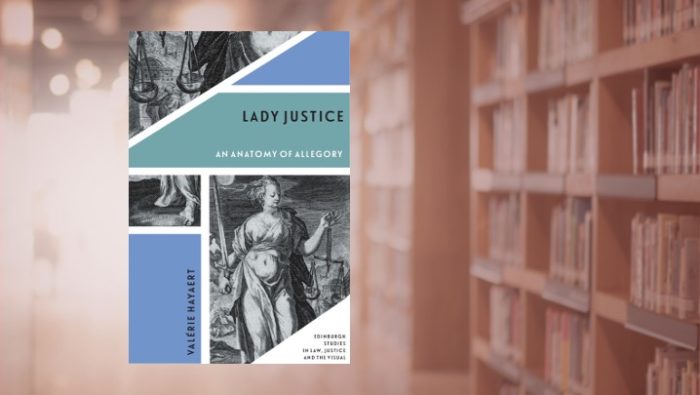
Encounters with Justice

Lady Justice has immediate appeal for students on a module I teach about law and visual art. Justice is a familiar figure in a foreign land that privileges image over text. Some students gratefully translate her paraphernalia of blindfold, scales, and sword into familiar legal concepts of impartiality, distributive justice, and retributive justice. Many also notice and decipher her whiteness and the kind of femininity she represents.
Valérie Hayaert’s Lady Justice: An Anatomy of an Allegory offers an alternative to such iconographic and semiotic analyses, which often overlook the visual and cling to the textual and the conceptual (p.3). She rightly says that such approaches ‘delimit the expressive possibilities of images’ (p.3), seeking to pin them either to a determinate iconographic language, or to an equally straitening structure of discursive power relations.
Lady Justice, by contrast, is all about the image. The book is a veritable treasure trove of Justices in multiple media, made in Europe mostly in the sixteenth and seventeenth centuries, and covering a rangy span from the 1300s (Lorenzetti’s Siena Allegories are discussed in Chapter 7) to the early twenty-first century (the Epilogue features works by Damien Hirst, Banksy, and Peter Greenaway). In presenting such a gorgeous array (literally: images of almost all works discussed are beautifully reproduced in the book), Hayaert immeasurably enriches our discipline’s reference points for imagining justice in female form.
Hayaert’s admirable aim is to open up “the plurality of meanings” generated by images of Justice. As a visual allegory in the form of a female figure, Justice, she argues, is a site of irresolvable ambivalence (p. 4-6, 20-23) and unstable encounters with viewers whose ‘affective responses’ are derived from their ‘experiences, not discourses’ (p. 28, 26). A magnificent ambition – but extremely difficult to achieve in a study that eschews empiricism.
Hayaert writes that ‘the allegories of Justice studied here will be perceived, read and valued through an understanding of the artist’s intention, the materiality of the artwork, and the disposition of its viewers’ (p.3). However, her desire to focus on artworks rather than texts has the unfortunate side-effect of excluding evidence of viewers’ experiences and of the material and cultural circumstances in which people encountered the artworks. Everything must be derived from the artwork itself. Thus, the book approaches the encounter between (an image of) embodied justice and a (mostly imagined) viewer from the side of the artwork alone.
Justitia takes on more reality and agency than the imagined viewer. Hayaert ‘dismember[s]’ the artwork’s body (p.1) and focuses on Justice’s emotions rather than dissecting the experience of its viewers. Thus, the fascinating ‘magical gaze’ in Chapter 6 belongs to the artwork not the viewer (p.234). In Chapter 1 Justitia is presented as an eloquent presence by way of an analogy with the rhetorical figure of eidolopoeia: as the dead speak through the orator, so Justice speaks through the image (p.56). Aby Warburg’s concept pathosformel enlivens Justitia in Chapter 4, enabling ‘affectivity to be stored and transmitted’ from the artwork to judges who view it (p.198). Absent empirical work aimed at bringing encounters between viewers and artworks to life, Hayaert relies on an alchemical aesthetics to animate the paintings, engravings, and statues of Justitia instead.
Evidence of viewing practices and effects is archival gold and perhaps not to be expected in large quantities. Rarities include the description in Chapter 7 of the indictment in the Parlement de Paris of the Méridol massacre which took place in the 1540s. One of the lawyers invoked elements of the visual allegory of Justice which could be seen by those in the building at the time (p.296-299). The discussion of l’ Horlogue du Palais de la Cité, a fourteenth-century clock topped by a bell and flanked by figures of Justitia and Lex, is similarly promising. Hayaert attends to its location just outside a legal precinct in Paris and reflects that it would be heard and seen by ordinary passers-by as well as jurists and court officials (p.242-246).
But such moments are fleeting and Hayaert is chary of letting textual sources steal the limelight from visual images, demurring, for instance, to engage with the voluminous literature on Lorenzetti’s Allegories on the grounds that it privileges textual sources at the expense of pictorial ones (p.290). Even Chapter 7, which promises to provide ‘a contrasting perception of Justice’ by looking at images that satirise and criticise (p.275), ends up attributing melancholy (p.278-282) and shame (p.288-290) to Justitia rather than investigating viewers’ emotional responses. Such images, Hayaert suggests, hold up a mirror to ‘the inner psychomachy that inhabits the judge’s conscience’ (p.310). Everything hangs on the reader’s willingness to buy into a speculative identification between judge and Justice.
Studying how artworks are and were viewed is not quite the same as analysing what artworks do or could mean. Focusing a study on the viewer or, as Hayaert does, the viewed, needn’t entail a choice between empirical and hermeneutic approaches. The formal properties of an artwork, the stylistic conventions of an aesthetic tradition, and the understandings characteristic of a given period influence the ways particular situated viewers see the work. At the same time, the material conditions in which artworks are encountered influence the ways viewers interpret them. In short, studying the encounter between artwork and viewer calls for a methodological encounter between the empirical and the hermeneutic.

